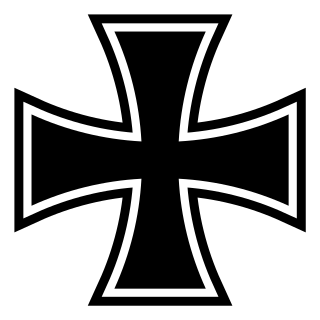
The Iron Cross was a military decoration in the Kingdom of Prussia, and later in the German Empire (1871–1918) and Nazi Germany (1933–1945). The design, a black cross pattée with a white or silver outline, was derived from the insignia of the medieval Teutonic Order and borne by its knights from the 13th century. As well as being a military medal, it has also been used as an emblem by the Prussian Army, the Imperial German Army, and the Reichswehr of the Weimar Republic, while the Balkenkreuz variant was used by the Wehrmacht. The Iron Cross is now the emblem of the Bundeswehr, the modern German armed forces.

The Pour le Mérite, also informally known as the Blue Max, is an order of merit established in 1740 by King Frederick II of Prussia. The Pour le Mérite was awarded as both a military and civil honour and ranked, along with the Order of the Black Eagle, the Order of the Red Eagle and the House Order of Hohenzollern, among the highest orders of merit in the Kingdom of Prussia. The order of merit was the highest royal Prussian order of bravery for officers of all ranks.

Eduard Wohlrat Christian Dietl was a German general during World War II who commanded the 20th Mountain Army. He received the Knight's Cross of the Iron Cross with Oak Leaves and Swords.

Hans-Valentin Hube was a German general during World War II who commanded armoured forces in the invasions of Poland, France and the Soviet Union. In the course of the war, Hube led the 16th Infantry Division, XIV Panzer Corps, and the 1st Panzer Army rising to the rank of Generaloberst. He died in an air crash on 21 April 1944.

The Order of the Red Eagle was an order of chivalry of the Kingdom of Prussia. It was awarded to both military personnel and civilians, to recognize valor in combat, excellence in military leadership, long and faithful service to the kingdom, or other achievements. As with most German other European orders, the Order of the Red Eagle could be awarded only to commissioned officers or civilians of approximately equivalent status. However, there was a medal of the order, which could be awarded to non-commissioned officers and enlisted men, lower ranking civil servants and other civilians.

Karl Mauss was a German general during World War II. He commanded the 7th Panzer Division and was one of only 27 German military men to receive the Knight's Cross of the Iron Cross with Oak Leaves, Swords and Diamonds.
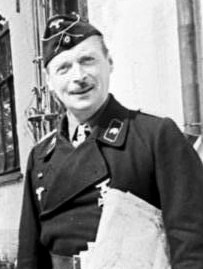
Hyazinth Graf Strachwitz was a German officer of aristocratic descent in the Wehrmacht during World War II. He was a recipient of the Knight's Cross of the Iron Cross with Oak Leaves, Swords and Diamonds.
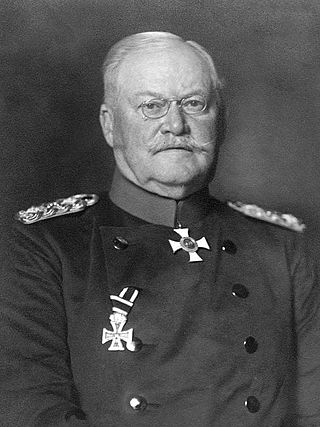
Maximilian “Max” Wilhelm Gustav Moritz von Prittwitz und Gaffron was an Imperial German general. He fought in the Austro-Prussian War, the Franco-Prussian War, and briefly in the First World War.

Political decorations of the Nazi Party were medals and awards issued by the National Socialist German Workers Party (NSDAP) between 1920 and 1945. Political awards were authorised for wear on any paramilitary uniform of Nazi Germany, as well as civilian attire, but were generally discouraged on Wehrmacht military uniforms. The Waffen-SS freely wore both political awards and military decorations on their uniforms.
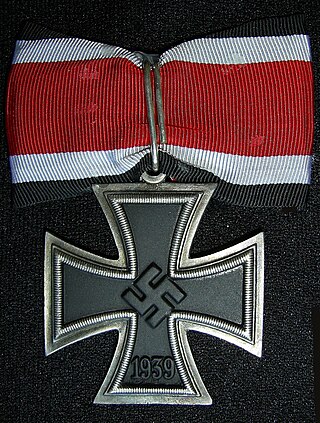
The Knight's Cross of the Iron Cross, or simply the Knight's Cross , and its variants, were the highest awards in the military and paramilitary forces of Nazi Germany during World War II. While it was lower in precedence than the Grand Cross of the Iron Cross, the Grand Cross was never awarded at-large to Nazi German military and paramilitary forces. The Grand Cross' sole award was made to Reichsmarschall Hermann Göring in September 1939, making the Knight's Cross the de facto highest award among the decorations of Nazi Germany.

The U-boat Front Clasp or U-boat Combat Clasp, was a World War II German Kriegsmarine military decoration awarded to holders of the U-boat War Badge to recognize continued combat service and valor.
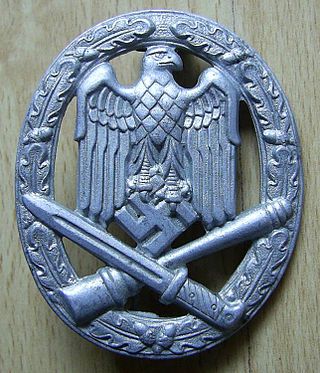
The General Assault Badge was a military decoration awarded during World War II to personnel of the German Army, Waffen-SS and Ordnungspolizei who supported an infantry attack but were not part of specific infantry units and therefore did not qualify for the Infantry Assault Badge. It was instituted by General Walther von Brauchitsch on 1 June 1940.

Friedrich Boedicker, was a Vizeadmiral of the Kaiserliche Marine during the First World War.
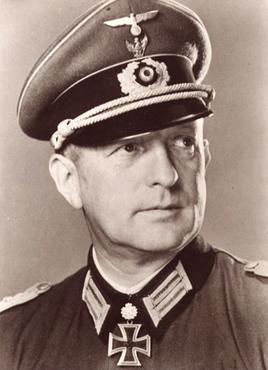
Walter Gorn was a highly decorated Generalmajor in the Wehrmacht of Nazi Germany during World War II who commanded several divisions. He was a recipient of the Knight's Cross of the Iron Cross with Oak Leaves and Swords.

Alfred-Hermann Reinhardt was a highly decorated German Generalleutnant in the Wehrmacht during World War II. He was a recipient of the Knight's Cross of the Iron Cross with Oak Leaves and Swords of Nazi Germany.
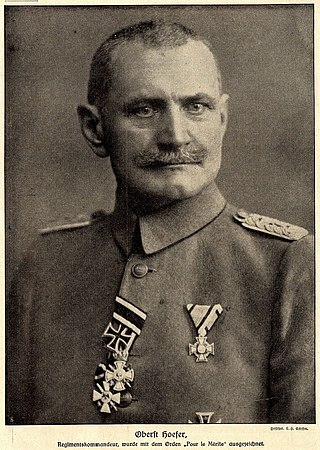
Karl Höfer also Hoefer; was a German general. During World War I he became known as the Held vom Kemmelberge (hero of Kemmel hill) after his division had captured the Kemmelberg during the Fourth Battle of Flanders.
The Honour Roll Clasp was a decoration of Nazi Germany during World War II. There were different versions for the Army (Heer), Air Force (Luftwaffe) and Navy (Kriegsmarine).

The Spanish Volunteer Medal formally known as the Commemorative Medal for Spanish Volunteers in the Struggle Against Bolshevism, commissioned 3 January 1944, was awarded by the Third Reich to recognize the men of the Blue Division who served at the Russian front during World War II. This force, attached to the Heer of the Wehrmacht, known as the 250th Infantry Division (span.), was in total composed of 47,000 men, sent by Francisco Franco to aid the Third Reich, as a way to pay back Adolf Hitler's help during the Spanish Civil War.
Helwig Fedor Johannes Luz was a highly decorated Generalleutnant in the Wehrmacht during World War II. He was a recipient of the Knight's Cross of the Iron Cross awarded for his service as Commander of Schützen-Regiment 110 during the Operation Barbarossa.
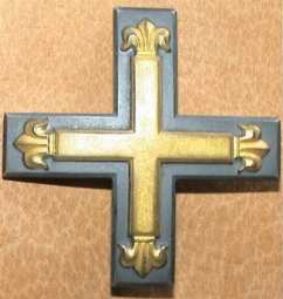
Awards of the German Freikorps were unofficial military awards displayed by various veteran organizations in Germany during the immediate aftermath of World War I. Upon the assumption of the Nazi Party to power in 1933, nearly all Freikorps awards were prohibited for wear on party, state, and military uniforms. Two notable exceptions were the Baltic Cross and Silesian Eagle. All other Freikorps awards were declared obsolete with World War I service thereafter recognized by a single award, known as the Honour Cross.


















